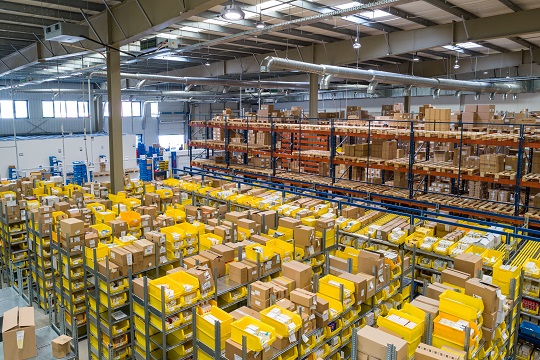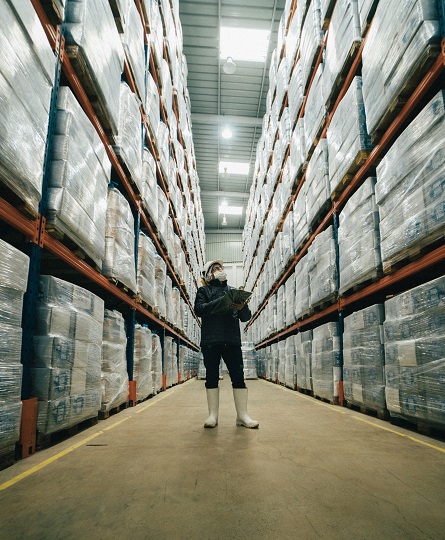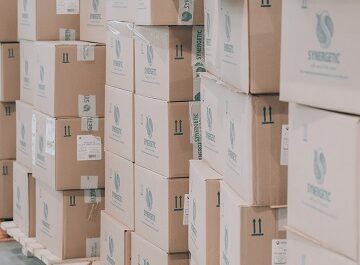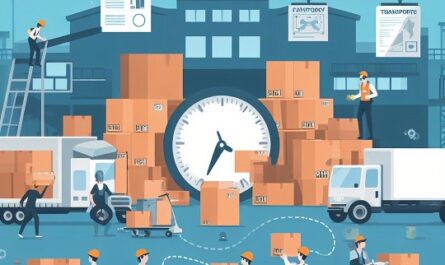Warehouses are super important in the supply chain. They store and move goods around. But because they have lots of valuable stuff, they’re often targets for thieves.
Stopping theft in warehouses is really important to keep things running smoothly and make customers happy.
In this blog, we’ll look at ten good ways to stop theft in warehouses.
Before we go further into this topic, don’t forget to follow my LinkedIn account. You’ll get more helpful insights on supply chain management there.
Table of Contents
Implement Robust Security Measures
Investing in security is super important for protecting stuff and people.
Things like cameras, alarms, and access control systems help stop bad guys from getting in and stealing things.
Cameras can watch everything and record what happens, which helps catch bad guys later.
Alarms and access control systems make sure someone knows if there’s a problem and can react fast.
These security measures make places safer for everyone, like employees, customers, and residents.
They give peace of mind and make people feel safer, especially in busy areas like stores, apartments, and parks.
So, investing in security not only protects things but also makes everyone feel better and trust that they’re safe.
Conduct Regular Security Audits
Regular security audits are super important for making sure security measures in warehouses work well.
These audits check everything like surveillance cameras, access controls, and alarms to find any weaknesses or gaps in security.
By doing this, businesses can find problems before bad guys do and fix them to stay safe.
Security audits also help warehouses stay updated on new threats and risks, so they can make changes to protect themselves better.
By fixing weaknesses found in security audits, warehouses can make sure they’re strong against potential threats.
Plus, by doing audits regularly and making improvements, warehouses show they’re serious about keeping things safe for their stuff, employees, and partners.
This makes everyone feel more confident that the warehouse is doing its best to stay secure and keep things running smoothly.
Screen and Train Employees
Thorough background checks and good training programs are really important for keeping warehouses safe.
Background checks help make sure that potential employees are trustworthy and don’t have a history of bad behavior. They look at things like criminal records, job history, and education to see if someone is a good fit for the job.

Training programs teach warehouse staff how to follow security rules, spot suspicious activity, and respond quickly in emergencies like theft or accidents. These programs should include practice drills so employees know what to do in different situations.
By training employees well and making sure they understand security procedures, warehouses can reduce the chances of something bad happening.
Also, investing in ongoing training shows that warehouses are serious about keeping things safe and making sure staff are ready for anything.
When background checks and training work together, warehouse staff can help keep the place secure and running smoothly.
Enforce Access Control
Keeping access limited to only authorized people using key cards, biometric systems, or security checkpoints is super important for preventing theft inside warehouses and secure facilities.
By having strict rules about who can go where, businesses can control who enters areas where valuable things are kept.
Key cards and biometric systems make sure that only the right employees can get into restricted areas.
Security checkpoints add an extra layer of protection by checking people before they’re allowed in, making sure they’re supposed to be there. These measures not only stop internal theft but also make warehouses safer overall and help things run smoothly.
By only letting authorized people in, warehouses can protect their valuable stuff and keep confidential information safe.
Plus, these rules make it easy to keep track of who’s coming and going, which helps if there’s ever a security problem.
By focusing on access control, warehouses can make sure they’re as secure as possible and ready to deal with any potential risks from internal theft or unauthorized access.
You might also like:
- 10 Ways Supply Chain Management Can Contribute to Business Profits
- 10 Conditions in which 3PL Costs Are More Expensive than Managing Logistics Yourself
Secure Perimeter and Entrances
Securing the outside of a warehouse with fences, gates, and good lighting is really important for keeping intruders out.
Fences make it clear where the property ends and show that it’s protected.
Gates that lock tight when the warehouse isn’t open send a strong message that no one should enter without permission.

Bright lights around the outside make it easier to see and scare away people who shouldn’t be there.
Together, these things make it hard for intruders to get into the warehouse, making it safer overall.
Also, making sure entrances and exits are secure is key. Strong locks on doors and extra barriers like metal bars or grilles make it tough for anyone to break in.
Using systems like key cards or biometric scanners at entrances means only the right people can get in.
By focusing on keeping entrances and exits safe, warehouses can control who comes in and out, reducing the chance of unauthorized access and making the warehouse more secure.
Utilize Inventory Management Systems
Using fancy inventory systems with barcode scanning and RFID technology makes managing warehouse goods way easier.
With barcode scanning, each item gets a special code, so it’s easy to track where it goes in the warehouse and beyond.
RFID takes it up a notch by automatically tracking items in real-time without needing someone to scan them manually.
This tech makes managing inventory smoother and more accurate because it cuts down on mistakes people might make when entering data by hand.
With these systems, warehouses can keep precise records of what they have, where it is, and how it moves, which helps them fill orders quickly and accurately.
Plus, these high-tech systems can quickly catch any mistakes or sneaky movements of goods.
If there’s a difference between what’s recorded and what’s actually in stock, warehouses can find out right away and fix it.
And because they can track items in real-time, they can also spot any funny business like unauthorized access or attempted theft right away.
By using these cool technologies, warehouses can not only manage inventory better but also keep their goods safe and accountable every step of the way.
Conduct Regular Inventory Audits
Regularly checking inventory is really important for warehouses to make sure their records match up with what’s actually in stock. These checks involve physically counting items and comparing them to what’s in the inventory system.
By doing this regularly, warehouses can catch any mistakes or problems, like errors in recording data, items going missing, or theft. This helps them fix any issues right away, so they don’t lose money or waste time.

Fixing problems found during inventory checks is crucial for warehouses to stop theft and keep better control of their inventory. By figuring out why there are differences and fixing them, warehouses can make sure it doesn’t happen again.
This might mean making security measures stronger, like adding more locks or training employees better, to stop theft and make sure only the right people can access inventory.
Also, by doing regular checks and keeping records up-to-date, warehouses can make better decisions about what to order and when.
Overall, by checking inventory regularly and fixing problems quickly, warehouses can make sure they’re more secure, keep better control of inventory, and avoid losing money due to theft or mistakes.
You might also like:
- 10 Strategies to Succeed in Supply Chain without Formal Education
- Top 10 Important Roles of Supervisors in Warehouse Operations
Collaborate with Law Enforcement
Building a good relationship with local law enforcement is a smart move for warehouses to boost their security and deal with theft. By working together and sharing information, warehouses can get help from the police in investigating thefts and getting back stolen goods.
Giving the police access to surveillance footage and other evidence helps them catch thieves faster. This teamwork not only increases the chances of getting stolen stuff back but also shows that warehouses are serious about stopping crime.
Also, reporting thefts to the police right away is important for getting help quickly. When warehouses report thefts promptly, the police can start looking for the thieves sooner and have a better chance of finding stolen things.
Plus, warehouses can learn from the police about how to improve security and prevent future thefts. By teaming up with local law enforcement, warehouses can make their operations safer, deter crime, and protect their stuff better.
Increase Employee Engagement
Encouraging employees to be active in security makes warehouses safer.
When employees feel responsible for security, they pay more attention and are quick to report anything suspicious. Training sessions and campaigns teach them why security matters and how to spot potential problems.

When employees help create security rules and can easily talk about security issues, they feel more committed to keeping the workplace safe.
Offering rewards for reporting suspicious activity is a good way to catch internal theft. Bonuses, recognition, or other rewards motivate employees to stay vigilant and report anything unusual.
Also, having ways for employees to report anonymously, like hotlines or online platforms, helps them feel safe to speak up without worrying about backlash.
By getting employees involved in security and rewarding them for their help, warehouses can make sure everyone works together to keep things safe and prevent theft.
Implement Loss Prevention Policies
Creating clear and specific rules to prevent theft and minimize losses is super important for warehouses.
These rules should cover things like improving physical security with locks and cameras, regularly checking inventory to catch any problems, and training employees to recognize and handle security issues.
By having these detailed rules in place, warehouses can create a structured plan to keep their assets safe. But it’s not just about preventing theft – warehouses also need a plan for what to do if something does happen.
This plan should include steps for reporting incidents, getting help quickly, and working with the police to investigate. It’s also important to explain what happens if someone breaks the rules, like stealing or ignoring security procedures.
By making it clear what the consequences are for breaking the rules, warehouses can make sure everyone takes security seriously and follows the plan to keep things safe.
Overall, having detailed rules and a plan for both preventing and responding to theft helps warehouses stay proactive and ready to protect against losses.
Conclusion
Preventing theft in warehouses needs a mix of strong security, training, tech, and working with the police.
By using these ten strategies, warehouses can lower the chance of theft, keep things safe, and make sure everything runs smoothly.
Staying alert and taking action early is important to keep warehouses secure and running well.
I hope you find it helpful!
Please share this article with your colleagues so they can also benefit. For more insights on supply chain management, follow my LinkedIn account. You’re free to use all articles on this blog for any purpose, even for commercial use, without needing to give credit.
 by
by 

